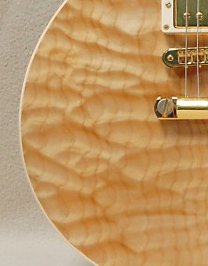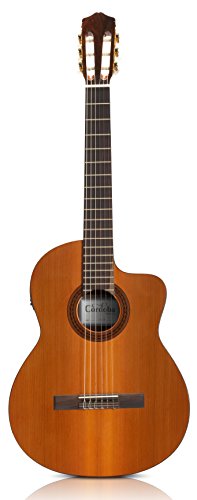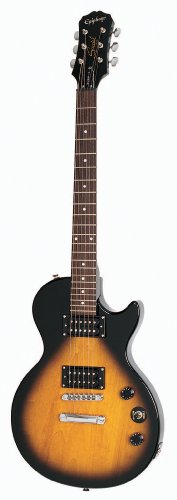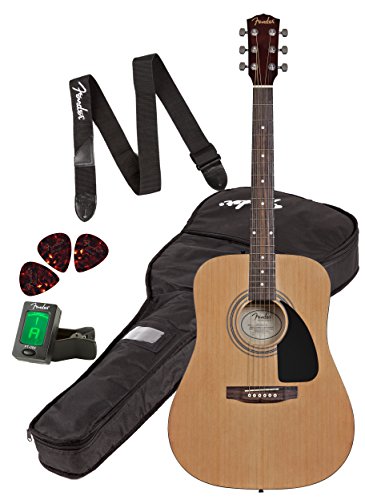Introduction to Beginner Guitars
What makes a great starter guitar?
5 Best Beginner Guitars
#5 Cordoba C5
#4 Yamaha FG-800
#3 The Black Strat
#2 The Epiphone Les Paul II
#1 Fender-FA100
Introduction to Beginner Guitars
Let me begin by congratulating you, or those your doing research for, on your new journey, the journey of guitar playing and a life of appreciating music. It most likely will take you places you had no idea you would go. When you have a deep seated passion for playing these six string instruments, or any instrument, it can give you endless enjoyment and be a friend for life. This page is dedicated to the 5 best beginner guitars from the world’s leading guitar brands. These are rated according to owner reviews. Of course there are many great guitars to learn on, these are just 5 of the best found at Cvhguitars.com.
What to look for in a beginner’s guitar?
 First and foremost is comfort . An instrument shouldn’t be awkward and unnatural. Yet, this is a very subjective topic as one player may prefer one thing, while another likes something different. Take paint jobs for example. Some people like red strats, some people aren’t that impressed. In reality, any guitar you are comfortable with is a good guitar for you. New and shiny instruments are great, but so are older instruments with some character. So this section will cover basic construction and what does it take to make a decent guitar for today’s beginners, from today’s materials.
First and foremost is comfort . An instrument shouldn’t be awkward and unnatural. Yet, this is a very subjective topic as one player may prefer one thing, while another likes something different. Take paint jobs for example. Some people like red strats, some people aren’t that impressed. In reality, any guitar you are comfortable with is a good guitar for you. New and shiny instruments are great, but so are older instruments with some character. So this section will cover basic construction and what does it take to make a decent guitar for today’s beginners, from today’s materials.
When you are shopping around for a new guitar it can be wildly overwhelming, especially when it’s all new to you. You can see one guitar for $250, and it looks exactly the same as a $2,500 model. Why? It is good to have a foundation of information to move forward and help you sort through the good, bad, and ugly. There are a lot of bad guitars out there, but there just as many good ones available too. These are the ingredients for a good-playing guitar recipe!
Key Components of a Quality Guitar-
- Construction Material
- Neck Quality
- Electronics
- Finish
Tone Woods-
 Many species of wood are used for guitars. Mostly builders use Spruce, Mahogany, Maple, Rosewood, Cedar, Ash, Basswood, and Ebony for entry level to high-end models. Instruments can be made of exotic woods as well, but these are generally found in handmade, or specifically made custom made guitars. For stratocaster style guitars the body woods are usually made of Ash or Alder which has a brighter. For many Les Paul style guitars it is generally a Mahogany body which give a warmer tone.
Many species of wood are used for guitars. Mostly builders use Spruce, Mahogany, Maple, Rosewood, Cedar, Ash, Basswood, and Ebony for entry level to high-end models. Instruments can be made of exotic woods as well, but these are generally found in handmade, or specifically made custom made guitars. For stratocaster style guitars the body woods are usually made of Ash or Alder which has a brighter. For many Les Paul style guitars it is generally a Mahogany body which give a warmer tone.
For today’s beginner guitars, there is also the use of laminates. These are very thin sheets of wood cut from a larger piece that usually has a desirable grain pattern which makes the instrument look good. The laminate is glued to a lower quality piece of wood that makes up the actual body structure, almost like wallpaper. This construction is mostly found in acoustic instruments as solid body electrics are…solid wood bodies.
Neck Precision-
 The neck of the instrument is the most important component of it’s construction. It is the part where all notes originate. Open strings use the nut as the “open fret” if you will, and all other notes (unless you use positions in front of the nut for bends, or the edge of the pickups as extra high pitch frets) use the metal frets as the breaking point of the string. A guitar will be hard to play and probably won’t produce a good ringing resonance throughout the instrument with out a decent neck set up.
The neck of the instrument is the most important component of it’s construction. It is the part where all notes originate. Open strings use the nut as the “open fret” if you will, and all other notes (unless you use positions in front of the nut for bends, or the edge of the pickups as extra high pitch frets) use the metal frets as the breaking point of the string. A guitar will be hard to play and probably won’t produce a good ringing resonance throughout the instrument with out a decent neck set up.
The nut is at the end of the fretboard where it meets the head stock and it’s job is to provide a breaking point for all open strings. The slots for each string should not be too deep as this will promote string buzzing at the nut. A good string slot leaves almost half the string diameter on exposed on top of the slot. Also the slots should be cut so the string breaks or angles down toward the head stock at the same angle as the head stock angle. This ensures proper intonation can be achieved and less sting breakage. For entry level guitars, nuts can be made of plastic, tusq, synthetics, and even bone.
Frets should be free of nics, dents and scratches. Any little defect on a fret will be clearly heard when a string is bent or fretted. Most beginner guitars have had very little fret work as this is a labor intensive practice. If the instrument is new and hasn’t been set up well, it would benefit the instrument to have a fret-leveling and recrowning and polishing. It’s not absolutely necessary, but will greatly improve the feel of the instrument when playing.
The fingerboard can be made of Rosewood, Ebony, Maple, and even newer synthetic materials such as Sonokeling. Sight down the edges of the neck and check for a nice straight fingerboard.  There may be a subtle curve known as “neck relief” near the middle, but overall the fingerboard should be level and even. Also check for any side to side warping along the length of the neck. It can be difficult to sight problems and it may be helpful to bring a notched straightedge if you’re really concerned. The size of the fingerboard and depth of the neck can make a huge difference in feel. Electric models are meant to be sleek and fast for the most part, and they are designed with narrower necks. Acoustics generally have wider necks but today’s modern guitars seem to keep getting narrower with each new generation. So take that into account when one guitar plays different than another.
There may be a subtle curve known as “neck relief” near the middle, but overall the fingerboard should be level and even. Also check for any side to side warping along the length of the neck. It can be difficult to sight problems and it may be helpful to bring a notched straightedge if you’re really concerned. The size of the fingerboard and depth of the neck can make a huge difference in feel. Electric models are meant to be sleek and fast for the most part, and they are designed with narrower necks. Acoustics generally have wider necks but today’s modern guitars seem to keep getting narrower with each new generation. So take that into account when one guitar plays different than another.
How the neck connects to the body should also be noted. There are three typical ways to put a neck on a guitar. First is the “bolt-on” neck. It is the simplest and most serviceable joint with the benefit of simply swapping necks with just a few hand tools. There is a slightly brighter snappier sound with “bolt-on” necks. Next is the “set-neck”. This method uses a pocket made in the guitar body to glue the neck into so there is no hardware at the neck joint. This tends to have a warmer tone than “bolt-on” necks. Last is the “neck-thru” design. This is a method that has the neck material extending all the way to the end of the guitar body. This is stronger than a “set-neck” as there is more structure attached to the neck. Again, it is believed that “neck-thru” guitars have a warmer tone than “bolt-on” necks. This is the most involved method of attaching the neck and that means it is usually the most expensive of the three. All three are have advantages and disadvantages, and all three methods are played on every single minute of the day. So it’s really your choice which you like best.
Electronics-
 Guitar electronics vary as much as the woods used to make the instrument. When it comes to name brands such as Fender for example, they will have a range from affordable low-end components, to high-end top quality parts. Things such as pickups, potentiometers , and jacks all have a range of quality. Electric guitars have a variety of pickup configurations, and many modern acoustics have a range of under saddle pickup systems so it’s not just the solid bodies that use electronics anymore. Due to the wide market for custom parts, some do a fantastic job, and others just get the job done. Also, this gets a bit subjective, as the style of music being played, the players technique, the amplifier, and everything in the chain makes a difference in sound.
Guitar electronics vary as much as the woods used to make the instrument. When it comes to name brands such as Fender for example, they will have a range from affordable low-end components, to high-end top quality parts. Things such as pickups, potentiometers , and jacks all have a range of quality. Electric guitars have a variety of pickup configurations, and many modern acoustics have a range of under saddle pickup systems so it’s not just the solid bodies that use electronics anymore. Due to the wide market for custom parts, some do a fantastic job, and others just get the job done. Also, this gets a bit subjective, as the style of music being played, the players technique, the amplifier, and everything in the chain makes a difference in sound.
There are thousands of parts to customize your guitar and it might not matter too much what electronics come pre-installed if you plan on doing customization. It again all comes down to style and tastes.
Finish-
 The finish on entry level guitars are generally polyurethane in nature. This makes for a strong and durable surface, but can ‘choke’ the sound especially in acoustic instruments. The more expensive guitars will use either a nitro-cellulose based finish, or even just a stain, such as that used on violins and cellos.
The finish on entry level guitars are generally polyurethane in nature. This makes for a strong and durable surface, but can ‘choke’ the sound especially in acoustic instruments. The more expensive guitars will use either a nitro-cellulose based finish, or even just a stain, such as that used on violins and cellos.
For a beginner, it won’t matter too much what the finish is made. In the begging, it might just be more important to have something that looks good, and you will want to play it. If the interest isn’t there then practicing and improving will be very challenging.
5 Best Beginner Guitars
This section is will cover both electric, and acoustic guitars. These guitars are rated as the 5 best beginner guitars from people who actually use them. They are well built and have unique features specific to each model. These are by no means the last word in entry level instruments, but they are all a great value and come with a reasonable price point for beginners.
#5 The Cordoba C5
At #5 we have a classical guitar. This is where real guitar playing all started. It has been said that the nylon string guitar contains all the timbres of the orchestra. It can produce brass, woodwind, string, and percussion all with the different techniques of the fingers and finger nails. Over time the classical guitar has been looked at as a toy instrument, when actually hidden inside are more tones than a Les Paul knows what to do with.  This Cordoba C5 is a great starter instrument that can be easily be played for years as a number one guitar, and it won’t change the monthly budget when you get it. Cordoba’s are being really well made these days and are getting great reviews from players.
This Cordoba C5 is a great starter instrument that can be easily be played for years as a number one guitar, and it won’t change the monthly budget when you get it. Cordoba’s are being really well made these days and are getting great reviews from players.
A pure distinct tone from the Cedar top and Mahogany sides rings like an acoustic three times the price. The Rosewood fingerboard has a smooth feel and the tuning machines keep everything where it should be tuning wise. You won’t be disappointed with this one if you’re interested in a nylon string guitar. Check out our page on How To Hot-Rod Your Nylon String Guitar where we take a Cordoba C5-CET and make it a smokin’ finger picking high performance machine.
Features
- A Solid Canadian Cedar top with laminated mahogany back and sides
- Single cutaway with Fishman Isys+ pickup
- A Rosewood bridge and fingerboard
- 50mm nut width for slightly slimmer neck
- Savarez Cristal Corum strings in High Tension, 500CJ
#4 Yamaha FG800
The Yamaha FG800 is a steel string acoustic with room filling strumming power. The on-board tuner and pre-amp let this guitar plug into an amp of PA and mix right in. Beautiful faded burst accent the solid Spruce top. Mahogany sides and back hum warm harmony to the top tone wood.
Features
- Body Body type: Dreadnought Cutaway: Single cutaway Top wood: Solid Spruce Back & sides: Nato/okume Bracing pattern: Scalloped X Body finish: Gloss Orientation: Right handed Neck Neck shape: Not specified Nut width: 1.69″ (43mm) Fingerboard: Rosewood Neck wood: Nato Scale length: 25.6″ Number of frets: 20 Neck finish: Matte Electronics Pickup/preamp: Yes Brand: Yamaha SYSTEM
- The FGX800C is the acoustic-electric version of the FG800
- New features include scalloped X bracing and a reverse L block neck attachment makes it an instrument that will last
- Solid spruce top and mahogany back and sides
- System 66 under-saddle piezo pickup developed by Yamaha
#3 Davison Strat
Here is the most recognized guitar body shape of all time, and the second most copied body shape ever (the dreadnought is #1). So there must be something to it. This is a perfect starter package to get your fingers moving on a fretboard. A single humbucker pickup with tone and volume controls can dial in the tone your looking for, and the included amp makes sure your heard. For a new guitar player who just wants a complete package to dive into playing head, hands and feet…it’s hard to beat this deal.
Features
- Full Scale Black Electric Guitar with Maple Neck
- Single Humbucker Pickup, volume and tone controls
- Case, Strap, Pitchpipe, Picks, Stringwinder, Cord
- Guitar Amp with Headphone Jack & Overdrive (distortion)
#2 The Epiphone Les Paul II

For beginners looking for an electric legend. Look no further than the Epiphone Les Paul II. This is a streamlined version of the granddaddy Gibson Les Paul Standard.
Features
- Solid Mahogany body
- Dual 700T Humbucker pickups
- A Rosewood fretboard
- 24.75 Scale Length
- Includes: 1×electric guitar, 1×guitar bag, 1×shoulder strap, 1×guitar pick, 1×amp cord
#1 Fender FA-100
The #1 guitar for beginners according to player reviews is the Fender FA-100 Dreadnought guitar package.  Not only do you get a solid steel string acoustic that rings for days, but you also get a Fender strap, a digital electronic tuner, a protective gig bag so your guitar has a home, and even a few picks. It’s everything you would need to get started and beginning your journey. The fingerboard and bridge are Rosewood and the saddle is made of bone for great sustain. There are a few different versions of the FA-100, this one is a Basswood Top. The full sized body gives loads of low-end bump with crisp highs and punchy mids. The price makes this a great instrument to learn on and you won’t have to worry too much about a little nic or bump from taking this one around the neighborhood.
Not only do you get a solid steel string acoustic that rings for days, but you also get a Fender strap, a digital electronic tuner, a protective gig bag so your guitar has a home, and even a few picks. It’s everything you would need to get started and beginning your journey. The fingerboard and bridge are Rosewood and the saddle is made of bone for great sustain. There are a few different versions of the FA-100, this one is a Basswood Top. The full sized body gives loads of low-end bump with crisp highs and punchy mids. The price makes this a great instrument to learn on and you won’t have to worry too much about a little nic or bump from taking this one around the neighborhood.
Features
- Protective Fender black nylon gig bag
- Keep this acoustic in proper playing position with the included Fender strap when standing or sitting from the factory installed forward facing strap button and rear strap button.
- Under the natural glossy Basswood top, the time tested quarter sawn X bracing adds to the distinct FA 100’s projection and top stability.
- Sophisticated modern construction techniques typically reserved for acoustics at much higher price points
- 1 Year Limited Warranty Included
Picking the Right Guitar for You
The best advise when starting to learn guitar is to follow your own path. The world is full of others doing what they do, and you will need to find your own path. Find what you enjoy and discover what doesn’t work for you. It’s the purest thing to do. Be warned it is very easy to fall into the trap of just copying someones playing or style. Learn, steal, borrow, and make it your own.
Now as far as instruments are concerned, there are some wonderful instruments being made today that don’t cost as much as a used car. Better manufacturing and better materials and better building processes are making great guitars affordable and eliminating those nasty instruments from a decade or two in the past. Above we have the 5 best beginner guitars, according to Cvhguitars.com, but that doesn’t mean an old guitar from the attic isn’t the best for you to learn on. Maybe it is. Also there are other complete guitar packages available as well. As stated before, it’s all subjective to tastes. Just follow your instincts, and of course the number one rule is to have fun.


